A Review of Critical State Joint Estimation Methods of Lithium-Ion Batteries in Electric Vehicles
Abstract
:1. Introduction
2. Single-State Estimation
2.1. Definition and Estimation Methods of SOC
2.1.1. Definition of SOC
2.1.2. Estimation Methods of SOC
2.2. Definition and Estimation Methods of SOH
2.2.1. Definition of SOH
- SOH is one of the important parameters of lithium-ion batteries, which is calibrated according to the change of battery capacity, as follows.
- 2.
- SOH is defined according to the internal resistance of the battery, as follows.
2.2.2. Estimation Methods of SOH
2.3. Definition and Estimation Methods of SOP
3. Dual-State Estimation
3.1. SOC/SOH Joint Estimation
3.1.1. Model-Based Estimation
3.1.2. Data-Driven Estimation
3.1.3. Fusion Estimation Algorithm Based on Data-Driven Approach and Model
3.2. SOC/SOP Joint Estimation
4. Key Issues and Future Work
4.1. Key Issues
4.1.1. Estimation Errors
4.1.2. Estimation Robustness
4.1.3. Division of Time Scale
4.2. Future Work
4.2.1. Joint Estimation of Battery Pack
4.2.2. Joint Estimation under Intelligent Network Connection
4.2.3. Integration Optimization
5. Conclusions
Author Contributions
Funding
Institutional Review Board Statement
Informed Consent Statement
Data Availability Statement
Conflicts of Interest
References
- See, K.W.; Wang, G.; Zhang, Y.; Wang, Y.; Meng, L.; Gu, X.; Zhang, N.; Lim, K.C.; Zhao, L.; Xie, B. Critical review and functional safety of a battery management system for large-scale lithium-ion battery pack technologies. Int. J. Coal. 2022, 9, 1–17. [Google Scholar] [CrossRef]
- Adenaw, L.; Krapf, S. Placing BEV Charging infrastructure: Influencing factors, metrics, and their influence on observed charger utilization. World Electr. Veh. J. 2022, 13, 56–72. [Google Scholar] [CrossRef]
- Kumar, B.; Khare, N.; Chaturvedi, P.K. FPGA-based design of advanced BMS implementing SoC/SoH estimators. Microelectron. Reliab. 2018, 84, 66–74. [Google Scholar] [CrossRef]
- Sun, F.; Xiong, R.; He, H. Estimation of state-of-charge and state-of-power capability of lithium-ion battery considering varying health conditions. J. Power Sources 2014, 259, 166–176. [Google Scholar] [CrossRef]
- Ren, H.; Zhao, Y.; Chen, S.; Wang, T. Design and implementation of a battery management system with active charge balance based on the SOC and SOH online estimation. Energy 2019, 166, 908–917. [Google Scholar] [CrossRef]
- Yang, B.; Wang, J.; Cao, P.; Zhu, T.; Shu, H.; Chen, J.; Zhang, J.; Zhu, J. Classification, summarization and perspectives on state-of-charge estimation of lithium-ion batteries used in electric vehicles: A critical comprehensive survey. J. Energy Storage 2021, 39, 102572. [Google Scholar] [CrossRef]
- Younes, M.B. Towards green driving: A review of efficient driving techniques. World Electr. Veh. J. 2022, 13, 103. [Google Scholar] [CrossRef]
- Li, Q.; Wang, T.; Li, S.; Chen, W.; Liu, H.; Breaz, E.; Gao, F. Online extremum seeking-based optimized energy management strategy for hybrid electric tram considering fuel cell degradation. Appl. Energy 2021, 285, 116505–118153. [Google Scholar] [CrossRef]
- Shrivastava, P.; Soon, T.K.; Idris, M.Y.I.B.; Mekhilef, S. Overview of model-based online state-of-charge estimation using Kalman filter family for lithium-ion batteries. Renew. Sustain. Energy Rev. 2019, 113, 109233. [Google Scholar] [CrossRef]
- Mevawalla, A.; Panchal, S.; Tran, M.K.; Fowler, M.; Fraser, R. One dimensional fast computational partial differential model for heat transfer in lithium-ion batteries. J. Power Sources. 2021, 37, 102471. [Google Scholar] [CrossRef]
- Li, Y.; Liu, K.; Foley, A.M.; Zülke, A.; Berecibar, M.; Nanini-Maury, E.; Van Mierlo, J.; Hoster, H.E. Data-driven health estimation and lifetime prediction of lithium-ion batteries: A review. Appl. Energy 2019, 113, 109254. [Google Scholar] [CrossRef]
- Xiao, D.; Fang, G.; Liu, S.; Yuan, S.; Ahmed, R.; Habibi, S.; Emadi, A. Reduced-coupling coestimation of SOC and SOH for lithium-ion batteries based on convex optimization. IEEE Trans. Power Electr. 2020, 35, 12332–12346. [Google Scholar] [CrossRef]
- Jiang, C.; Wang, S.; Wu, B.; Fernandez, C.; Xiong, X.; Coffie-Ken, J. A state-of-charge estimation method of the power lithium-ion battery in complex conditions based on adaptive square root extended Kalman filter. Energy 2021, 219, 119603. [Google Scholar] [CrossRef]
- Wang, Y.; Tian, J.; Sun, Z.; Wang, L.; Xu, R.; Li, M.; Chen, Z. A comprehensive review of battery modeling and state estimation approaches for advanced battery management systems. Renew. Sustain. Energy Rev. 2020, 131, 110015. [Google Scholar] [CrossRef]
- Rivera-Barrera, J.; Muñoz-Galeano, N.; Sarmiento-Maldonado, H. SoC Estimation for Lithium-ion Batteries: Review and future challenges. Electronics 2017, 6, 102. [Google Scholar] [CrossRef]
- How, D.N.T.; Hannan, M.A.; Hossain Lipu, M.S.; Ker, P.J. State of charge estimation for lithium-ion batteries using model-based and data-driven methods: A review. IEEE Access 2019, 7, 136116–136136. [Google Scholar] [CrossRef]
- Li, S.; Wang, K. The literature review on control methods of SOH and SOC for supercapacitors. In Proceedings of the 2019 4th International Conference on Control, Robotics and Cybernetics (CRC), Tokyo, Japan, 27–30 September 2019; pp. 17–21. [Google Scholar]
- Hung, M.H.; Lin, C.H.; Lee, L.C.; Wang, C.M. State-of-charge and state-of-health estimation for lithium-ion batteries based on dynamic impedance technique. J. Power Sources 2014, 268, 861–873. [Google Scholar] [CrossRef]
- Wang, Q.; Ye, M.; Wei, M.; Lian, G.; Wu, C. Co-estimation of state of charge and capacity for lithium-ion battery based on recurrent neural network and support vector machine. Energy Rep. 2021, 7, 7323–7332. [Google Scholar] [CrossRef]
- Vidal, C.; Malysz, P.; Kollmeyer, P.; Emadi, A. Machine learning applied to electrified vehicle battery state of charge and state of health estimation: State-of-the-art. IEEE Access 2020, 8, 52796–52814. [Google Scholar] [CrossRef]
- Guo, R.; Shen, W. A review of equivalent circuit model based online state of power estimation for lithium-ion batteries in electric vehicles. Vehicles 2021, 4, 1–29. [Google Scholar] [CrossRef]
- Liu, K.; Li, K.; Peng, Q.; Zhang, C. A brief review on key technologies in the battery management system of electric vehicles. Front. Mech. Eng. 2018, 14, 47–64. [Google Scholar] [CrossRef]
- Li, X.; Wang, Z.; Zhang, L.; Zou, C.; Dorrell, D.D. State-of-health estimation for Li-ion batteries by combing the incremental capacity analysis method with grey relational analysis. J. Power Sources 2019, 410, 106–114. [Google Scholar] [CrossRef]
- Xiong, R.; Sun, F.; He, H.; Nguyen, T.D. A data-driven adaptive state of charge and power capability joint estimator of lithium-ion polymer battery used in electric vehicles. Energy 2013, 63, 295–308. [Google Scholar] [CrossRef]
- Deng, Z.; Hu, X.; Lin, X.; Che, Y.; Xu, L.; Guo, W. Data-driven state of charge estimation for lithium-ion battery packs based on Gaussian process regression. Energy 2020, 205, 118000. [Google Scholar] [CrossRef]
- Bi, Y.; Choe, S.Y. An adaptive sigma-point Kalman filter with state equality constraints for online state-of-charge estimation of a Li(NiMnCo)O2/Carbon battery using a reduced-order electrochemical model. Appl. Energy 2020, 258, 113925–113997. [Google Scholar] [CrossRef]
- Lai, X.; Zheng, Y.; Sun, T. A comparative study of different equivalent circuit models for estimating state-of-charge of lithium-ion batteries. Electrochim. Acta 2018, 259, 566–577. [Google Scholar] [CrossRef]
- Wei, Z.; Hu, J.; He, H.; Li, Y.; Xiong, B. Load current and state-of-charge coestimation for current sensor-free lithium-ion battery. IEEE Trans. Power Electr. 2021, 36, 10970–10975. [Google Scholar] [CrossRef]
- Wang, R.; Sun, Q.; Hu, W.; Li, Y.; Ma, D.; Wang, P. SoC-based droop coefficients stability region analysis of the battery for stand-alone supply systems with constant power loads. IEEE Trans. Power Electr. 2021, 36, 7866–7879. [Google Scholar] [CrossRef]
- Chang, C.; Wang, Q.; Jiang, J.; Wu, T. Lithium-ion battery state of health estimation using the incremental capacity and wavelet neural networks with genetic algorithm. J. Energy Storage 2021, 38, 678–685. [Google Scholar] [CrossRef]
- Zhu, J.; Dewi Darma, M.S.; Knapp, M.; Sørensen, D.R.; Heere, M.; Fang, Q.; Wang, X.; Dai, H.; Mereacre, L.; Senyshyn, A.; et al. Investigation of lithium-ion battery degradation mechanisms by combining differential voltage analysis and alternating current impedance. J. Power Sources 2020, 448, 227575. [Google Scholar] [CrossRef]
- Shen, Y. Hybrid unscented particle filter based state-of-charge determination for lead-acid batteries. Energy 2014, 74, 795–803. [Google Scholar] [CrossRef]
- Bian, X.; Wei, Z.G.A.E.; Li, W.; Pou, J.; Sauer, D.U.; Liu, L. State-of-health estimation of lithium-ion batteries by fusing an open-circuit-voltage model and incremental capacity analysis. IEEE Trans. Power Electr. 2021, 1, 2226–2236. [Google Scholar] [CrossRef]
- Wang, Z.; Zeng, S.; Guo, J.; Qin, T. State of health estimation of lithium-ion batteries based on the constant voltage charging curve. Energy 2019, 167, 661–669. [Google Scholar] [CrossRef]
- Berecibar, M.; Gandiaga, I.; Villarreal, I.; Omar, N.; Van Mierlo, J.; Van den Bossche, P. Critical review of state of health estimation methods of Li-ion batteries for real applications. Renew. Sustain. Energy Rev. 2016, 56, 572–587. [Google Scholar] [CrossRef]
- Guo, P.; Cheng, Z.; Yang, L. A data-driven remaining capacity estimation approach for lithium-ion batteries based on charging health feature extraction. J. Power Sources 2019, 412, 442–450. [Google Scholar] [CrossRef]
- Tian, J.; Xiong, R.; Yu, Q. Fractional-order model-based incremental capacity analysis for degradation state recognition of lithium-ion batteries. IEEE Trans. Ind. Electron. 2019, 66, 1576–1584. [Google Scholar] [CrossRef]
- Tian, J.; Xiong, R.; Shen, W. A review on state of health estimation for lithiumion batteries in photovoltaic systems. Transportation 2019, 2, 100028. [Google Scholar]
- Lipu, M.S.H.; Hannan, M.A.; Hussain, A.; Hoque, M.M.; Ker, P.J.; Saad, M.H.M.; Ayob, A. A review of state of health and remaining useful life estimation methods for lithium-ion battery in electric vehicles: Challenges and recommendations. J. Clean. Prod. 2018, 205, 115–133. [Google Scholar] [CrossRef]
- Deng, Y.; Ying, H.; Jiaqiang, E.; Zhu, H.; Wei, K.; Chen, J.; Zhang, F.; Liao, G. Feature parameter extraction and intelligent estimation of the State-of-Health of lithium-ion batteries. Energy 2019, 176, 91–102. [Google Scholar] [CrossRef]
- Zhu, J.; Wang, Y.; Huang, Y.; Bhushan Gopaluni, R.; Cao, Y.; Heere, M.; Muhlbauer, M.J.; Mereacre, L.; Dai, H.; Liu, X.; et al. Data-driven capacity estimation of commercial lithium-ion batteries from voltage relaxation. Nat. Commun. 2022, 13, 2261. [Google Scholar] [CrossRef]
- Oji, T.; Zhou, Y.; Ci, S.; Kang, F.; Chen, X.; Liu, X. Data-driven methods for battery SOH estimation: Survey and a critical analysis. IEEE Access 2021, 9, 126903–126916. [Google Scholar] [CrossRef]
- Zhang, S.; Guo, X.; Dou, X.; Zhang, X. A rapid online calculation method for state of health of lithium-ion battery based on coulomb counting method and differential voltage analysis. J. Power Sources. 2020, 479, 228740. [Google Scholar] [CrossRef]
- Catelani, M.; Ciani, L.; Fantacci, R.; Patrizi, G.; Picano, B. Remaining useful life estimation for prognostics of lithium-ion batteries based on recurrent neural network. IEEE Trans. Instrum. Meas. 2021, 70, 1–11. [Google Scholar] [CrossRef]
- Chen, C.; Xiong, R.; Yang, R.; Shen, W.; Sun, F. State-of-charge estimation of lithium-ion battery using an improved neural network model and extended Kalman filter. J. Clean. Prod. 2019, 234, 1153–1164. [Google Scholar] [CrossRef]
- Bao, Z.; Jiang, J.; Zhu, C.; Gao, M. A new hybrid neural network method for state-of-health estimation of lithium-ion battery. Energies 2022, 15, 4399. [Google Scholar] [CrossRef]
- Yang, N.; Song, Z.; Hofmann, H.; Sun, J. Robust state of health estimation of lithium-ion batteries using convolutional neural network and random forest. J. Energy Storage 2022, 48, 103857. [Google Scholar] [CrossRef]
- Venugopal, P. State-of-health estimation of Li-ion batteries in electric vehicle using IndRNN under variable load condition. Energies 2019, 12, 4338. [Google Scholar] [CrossRef]
- Zhao, C.; Hashemi, S.; Andersen, P.B.; Traholt, C. Data-driven state of health modeling of battery energy storage systems providing grid services. In Proceedings of the 11th International Conference on Power, Energy and Electrical Engineering (CPEEE), Shiga, Japan, 26–28 February 2021; pp. 43–49. [Google Scholar]
- Chen, J.; Feng, X.; Jiang, L.; Zhu, Q. State of charge estimation of lithium-ion battery using denoising autoencoder and gated recurrent unit recurrent neural network. Energy 2021, 227, 120451. [Google Scholar] [CrossRef]
- Zhu, R.; Duan, B.; Zhang, J.; Zhang, Q.; Zhang, C. Co-estimation of model parameters and state-of-charge for lithium-ion batteries with recursive restricted total least squares and unscented Kalman filter. Appl. Energy 2020, 277, 115494. [Google Scholar] [CrossRef]
- Zuo, H.; Zhang, B.; Huang, Z.; Wei, K.; Zhu, H.; Tan, J. Effect analysis on SOC values of the power lithium manganate battery during discharging process and its intelligent estimation. Energy 2022, 238, 121854. [Google Scholar] [CrossRef]
- Lai, X.; Huang, Y.; Gu, H.; Han, X.; Feng, X.; Dai, H.; Zheng, Y.; Ouyang, M. Remaining discharge energy estimation for lithium-ion batteries based on future load prediction considering temperature and ageing effects. Energy 2022, 238, 121754. [Google Scholar] [CrossRef]
- He, Y.; Liu, X.; Zhang, C.; Chen, Z. A new model for State-of-Charge (SOC) estimation for high-power Li-ion batteries. Appl. Energy 2013, 101, 808–814. [Google Scholar] [CrossRef]
- Zhu, Q.; Xu, M.; Liu, W.; Zheng, M. A state of charge estimation method for lithium-ion batteries based on fractional order adaptive extended kalman filter. Energy 2019, 187, 115880. [Google Scholar] [CrossRef]
- Xiao, B.; Liu, Y.; Xiao, B. Accurate state-of-charge estimation approach for lithium-ion batteries by gated recurrent unit with ensemble optimizer. IEEE Access 2019, 7, 54192–54202. [Google Scholar] [CrossRef]
- Chen, Z.; Yang, L.; Zhao, X.; Wang, Y.; He, Z. Online state of charge estimation of Li-ion battery based on an improved unscented Kalman filter approach. Appl. Math. Model 2019, 70, 532–544. [Google Scholar] [CrossRef]
- Shen, Y. Adaptive extended Kalman filter based state of charge determination for lithium-ion batteries. Electrochim. Acta 2018, 283, 1432–1440. [Google Scholar] [CrossRef]
- Kim, J.; Lee, S.; Cho, B.H. Complementary Cooperation Algorithm Based on DEKF combined with pattern recognition for SOC/capacity estimation and SOH prediction. IEEE Trans. Power Electr. 2012, 27, 436–451. [Google Scholar] [CrossRef]
- Wang, Z.; Gladwin, D.T.; Smith, M.J.; Haass, S. Practical state estimation using Kalman filter methods for large-scale battery systems. Appl. Energy 2021, 294, 117022. [Google Scholar] [CrossRef]
- Wu, T.H.; Moo, C.S. State-of-charge estimation with state-of-health calibration for lithium-ion batteries. Energies 2017, 10, 987. [Google Scholar] [CrossRef]
- Li, D.; Zhang, Z.; Liu, P.; Wang, Z.; Zhang, L. Battery fault diagnosis for electric vehicles based on voltage abnormality by combining the long short-term memory neural network and the equivalent circuit model. IEEE Trans. Power Electr. 2021, 36, 1303–1315. [Google Scholar] [CrossRef]
- Zou, Y.; Hu, X.; Ma, H.; Li, S.E. Combined state of charge and state of health estimation over lithium-ion battery cell cycle lifespan for electric vehicles. J. Power Sources 2015, 273, 793–803. [Google Scholar] [CrossRef]
- Sepasi, S.; Ghorbani, R.; Liaw, B.Y. Inline state of health estimation of lithium-ion batteries using state of charge calculation. J. Power Sources 2015, 299, 246–254. [Google Scholar] [CrossRef]
- El Mejdoubi, A.; Oukaour, A.; Chaoui, H.; Gualous, H.; Sabor, J.; Slamani, Y. State-of-charge and state-of-health lithium-ion batteries’ diagnosis according to surface temperature variation. IEEE Trans. Ind. Electron. 2016, 63, 2391–2402. [Google Scholar] [CrossRef]
- Du, J.; Liu, Z.; Wang, Y.; Wen, C. An adaptive sliding mode observer for lithium-ion battery state of charge and state of health estimation in electric vehicles. Control Eng. Pract. 2016, 54, 81–90. [Google Scholar] [CrossRef]
- Chemali, E.; Kollmeyer, P.J.; Preindl, M.; Fahmy, Y.; Emadi, A. A convolutional neural network approach for estimation of Li-ion battery state of health from charge profiles. Energies 2022, 15, 1185. [Google Scholar] [CrossRef]
- Zhao, R.; Kollmeyer, P.J.; Lorenz, R.D.; Jahns, T.M. A compact methodology via a recurrent neural network for accurate equivalent circuit type modeling of lithium-ion batteries. IEEE Trans. Ind. Appl. 2019, 55, 1922–1931. [Google Scholar] [CrossRef]
- Cui, S.; Su, Y.; Qing dao er ji, R.; Ji, Y. An end-to-end network for irregular printed Mongolian recognition. Int. J. Doc. Anal. Recog. 2021, 25, 41–50. [Google Scholar] [CrossRef]
- Tong, S.; Klein, M.P.; Park, J.W. On-line optimization of battery open circuit voltage for improved state-of-charge and state-of-health estimation. J. Power Sources. 2015, 293, 416–428. [Google Scholar] [CrossRef]
- Yan, W.; Zhang, B.; Zhao, G.; Tang, S.; Niu, G.; Wang, X. A battery management system with a lebesgue-sampling-based extended Kalman filter. IEEE Trans. Ind. Electron. 2019, 66, 3227–3236. [Google Scholar] [CrossRef]
- Cacciato, M.; Nobile, G.; Scarcella, G.; Scelba, G. Real-Time Model-Based Estimation of SOC and SOH for energy storage systems. IEEE Trans. Power Electr. 2017, 32, 794–803. [Google Scholar] [CrossRef]
- Chaoui, H.; Golbon, N.; Hmouz, I.; Souissi, R.; Tahar, S. Lyapunov-based adaptive state of charge and state of health estimation for lithium-ion batteries. IEEE Trans. Ind. Electron. 2015, 62, 1610–1618. [Google Scholar] [CrossRef]
- Jin, X.B.; Robert Jeremiah, R.J.; Su, T.L.; Bai, Y.T.; Kong, J.L. The New Trend of State Estimation: From model-driven to hybrid-driven methods. Sensors 2021, 21, 2085. [Google Scholar] [CrossRef]
- Dang, X.; Yan, L.; Xu, K.; Wu, X.; Jiang, H.; Sun, H. Open-circuit voltage-based state of charge estimation of lithium-ion battery using dual neural network fusion battery model. Electrochim. Acta 2016, 188, 356–366. [Google Scholar] [CrossRef]
- Jo, S.; Jung, S.; Roh, T. Battery state-of-health estimation using machine learning and preprocessing with relative state-of-charge. Energies 2021, 14, 7206. [Google Scholar] [CrossRef]
- Liu, D.; Li, L.; Song, Y.; Wu, L.; Peng, Y. Hybrid state of charge estimation for lithium-ion battery under dynamic operating conditions. Int. J. Electr. Power 2019, 110, 48–61. [Google Scholar] [CrossRef]
- Mondal, A.; Routray, A.; Puravankara, S. Parameter identification and co-estimation of state-of-charge of Li-ion battery in real-time on internet-of-things platform. J. Energy Storage 2022, 51, 104370. [Google Scholar] [CrossRef]
- Sun, D.; Yu, X.; Wang, C.; Zhang, C.; Huang, R.; Zhou, Q.; Amietszajew, T.; Bhagat, R. State of charge estimation for lithium-ion battery based on an intelligent adaptive extended kalman filter with improved noise estimator. Energy 2021, 214, 119025. [Google Scholar] [CrossRef]
- Wei, C.; Benosman, M.; Kim, T. Online parameter identification for state of power prediction of lithium-ion batteries in electric vehicles using extremum seeking. Int. J. Control Autom. 2019, 17, 2906–2916. [Google Scholar] [CrossRef]
- Farmann, A.; Sauer, D.U. A comprehensive review of on-board state-of-available-power prediction techniques for lithium-ion batteries in electric vehicles. J. Power Sources 2016, 329, 123–137. [Google Scholar] [CrossRef]
- Esfandyari, M.J.; Esfahanian, V.; Hairi Yazdi, M.R.; Nehzati, H.; Shekoofa, O. A new approach to consider the influence of aging state on Lithium-ion battery state of power estimation for hybrid electric vehicle. Energy 2019, 176, 505–520. [Google Scholar] [CrossRef]
- Tang, X.; Wang, Y.; Yao, K.; He, Z.; Gao, F. Model migration based battery power capability evaluation considering uncertainties of temperature and aging. J. Power Sources 2019, 440, 227141. [Google Scholar] [CrossRef]
- Tian, Y.; Lai, R.; Li, X.; Xiang, L.; Tian, J. A combined method for state-of-charge estimation for lithium-ion batteries using a long short-term memory network and an adaptive cubature Kalman filter. Appl. Energy 2020, 265, 114789. [Google Scholar] [CrossRef]
- Bian, X.; Wei, Z.; He, J.; Yan, F.; Liu, L. A Two-step parameter optimization method for low-order model-based state-of-charge estimation. IEEE Trans. Transp. Electr. 2021, 7, 399–409. [Google Scholar] [CrossRef]
- Kim, T.; Song, W.; Son, D.Y.; Ono, L.K.; Qi, Y. Lithium-ion batteries: Outlook on present, future, and hybridized technologies. J. Mater. Chem. A 2019, 7, 2942–2964. [Google Scholar] [CrossRef]
- Nazir, H.; Batool, M.; Bolivar Osorio, F.J.; Isaza-Ruiz, M.; Xu, X.; Vignarooban, K.; Phelan, P.; Inamuddin; Kannan, A.M. Recent developments in phase change materials for energy storage applications: A review. Int. J. Heat Mass Tran. 2019, 129, 491–523. [Google Scholar] [CrossRef]
- Xu, P.; Li, J.; Sun, C.; Yang, G.; Sun, F. Adaptive state-of-charge estimation for lithium-ion batteries by considering capacity degradation. Electronics 2021, 10, 122. [Google Scholar] [CrossRef]
- Li, X.; Wang, Z.; Zhang, L. Co-estimation of capacity and state-of-charge for lithium-ion batteries in electric vehicles. Energy 2019, 174, 33–44. [Google Scholar] [CrossRef]
- Xu, J.; Jia, Y.; Liu, B.; Zhao, H.; Yu, H.; Li, J.; Yin, S. Coupling effect of state-of-health and state-of-charge on the mechanical integrity of lithium-ion batteries. Exp. Mech. 2018, 58, 633–643. [Google Scholar] [CrossRef]
- Hu, X.; Jiang, H.; Feng, F.; Liu, B. An enhanced multi-state estimation hierarchy for advanced lithium-ion battery management. Appl. Energy 2020, 257, 114019–117916. [Google Scholar] [CrossRef]
- Guo, F.; Hu, G.; Xiang, S.; Zhou, P.; Hong, R.; Xiong, N. A multi-scale parameter adaptive method for state of charge and parameter estimation of lithium-ion batteries using dual Kalman filters. Energy 2019, 178, 79–88. [Google Scholar] [CrossRef]
- Qian, K.F.; Liu, X.T. Hybrid optimization strategy for lithium-ion battery’s state of charge/health using joint of dual Kalman filter and modified sine-cosine algorithm. J. Energy Storage 2021, 44, 103319. [Google Scholar] [CrossRef]
- Ma, L.; Xu, Y.; Zhang, H.; Yang, F.; Wang, X.; Li, C. Co-estimation of state of charge and state of health for lithium-ion batteries based on fractional-order model with multi-innovations unscented Kalman filter method. J. Energy Storage 2022, 52, 140940. [Google Scholar] [CrossRef]
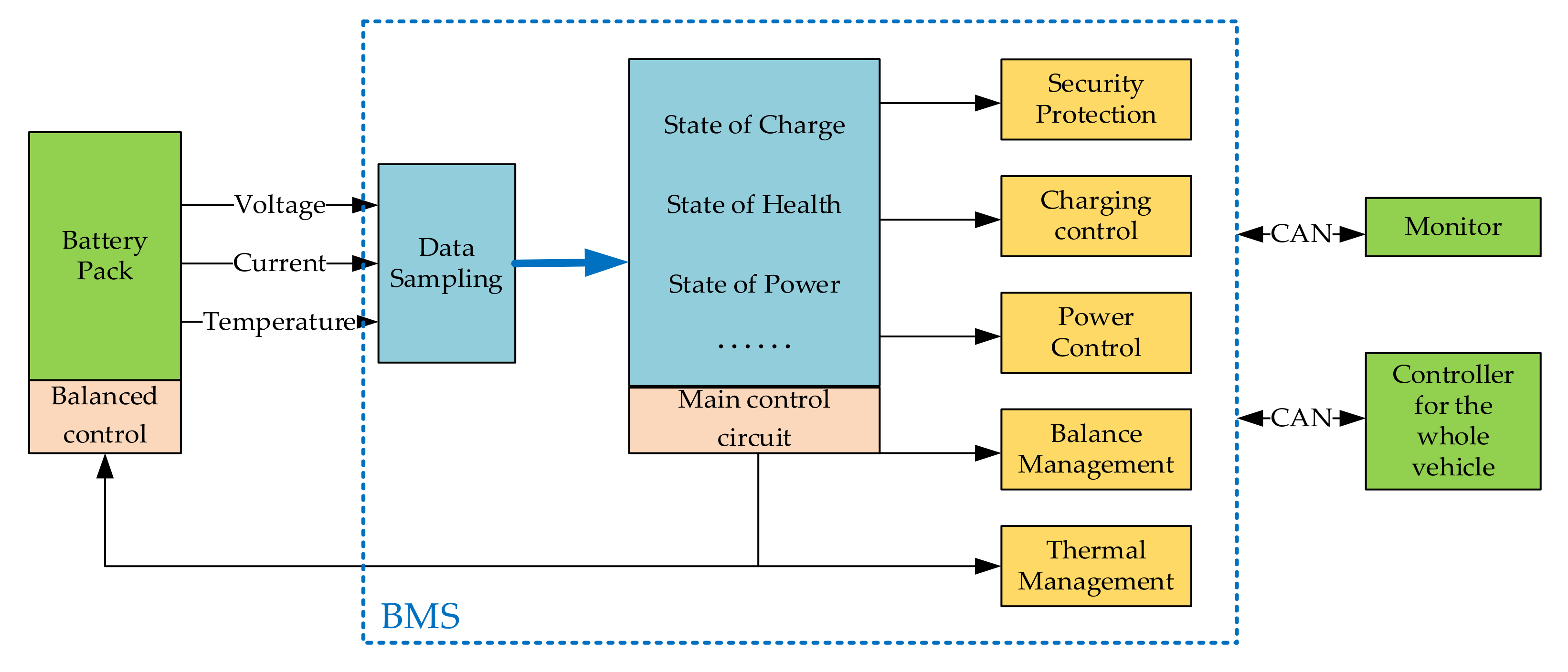


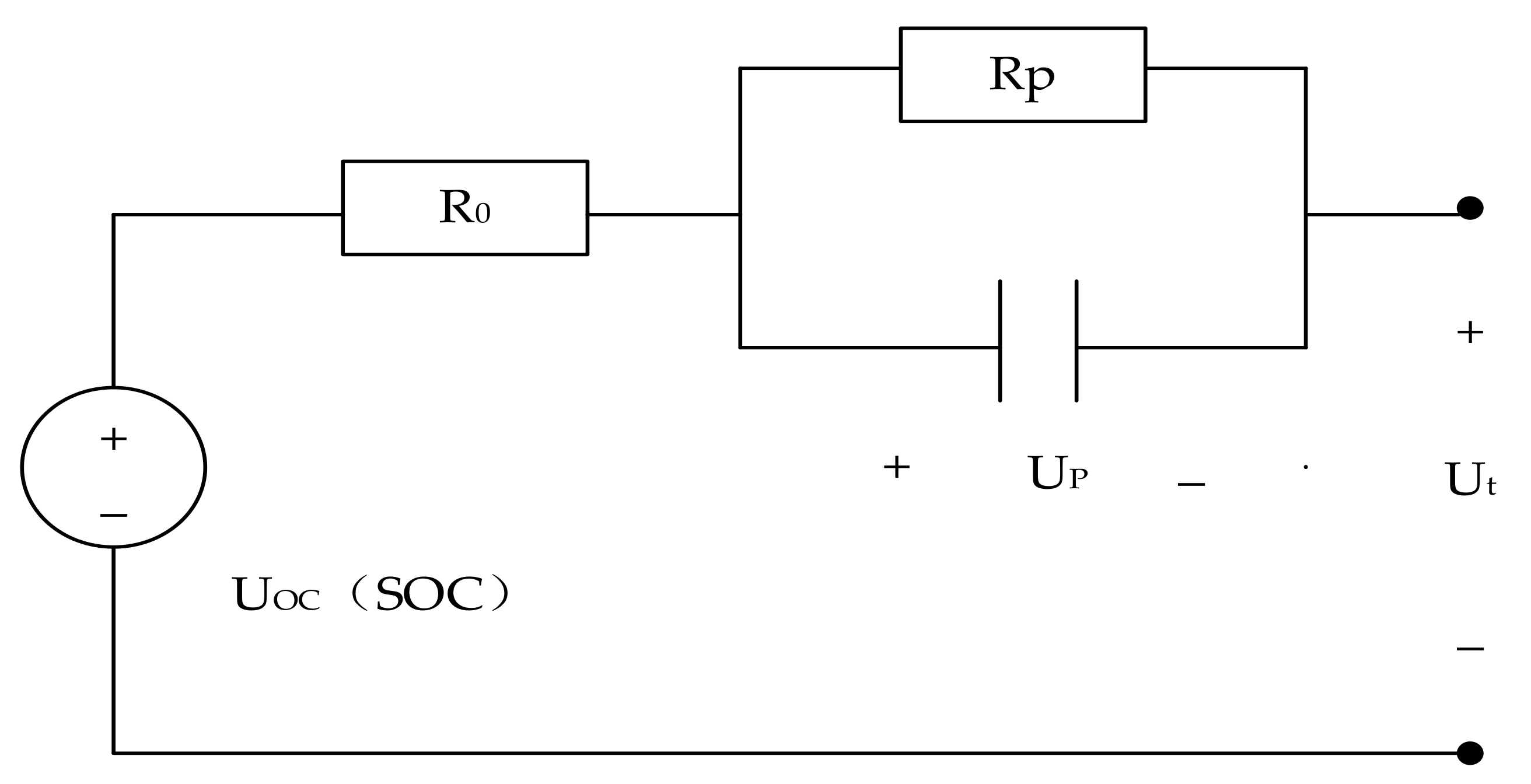
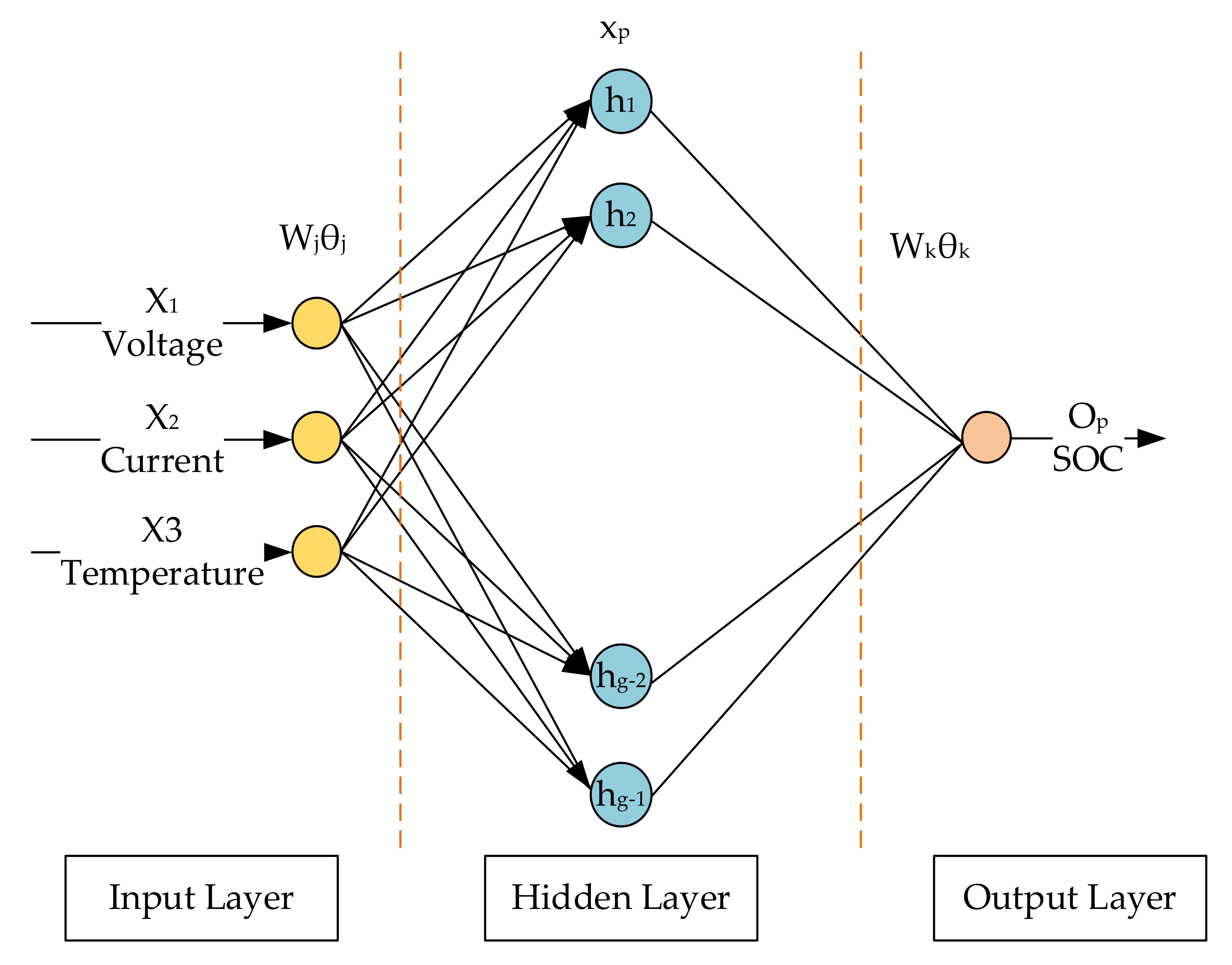



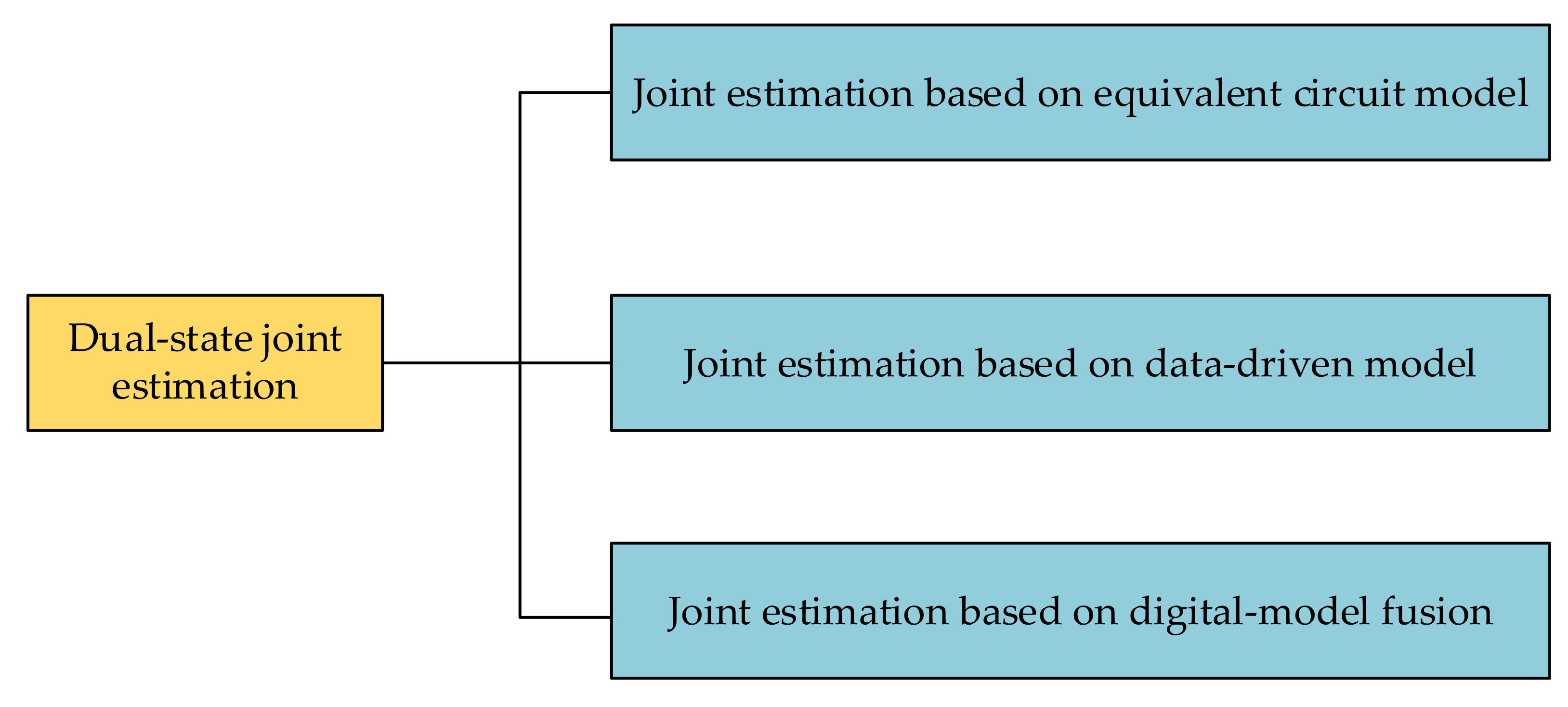





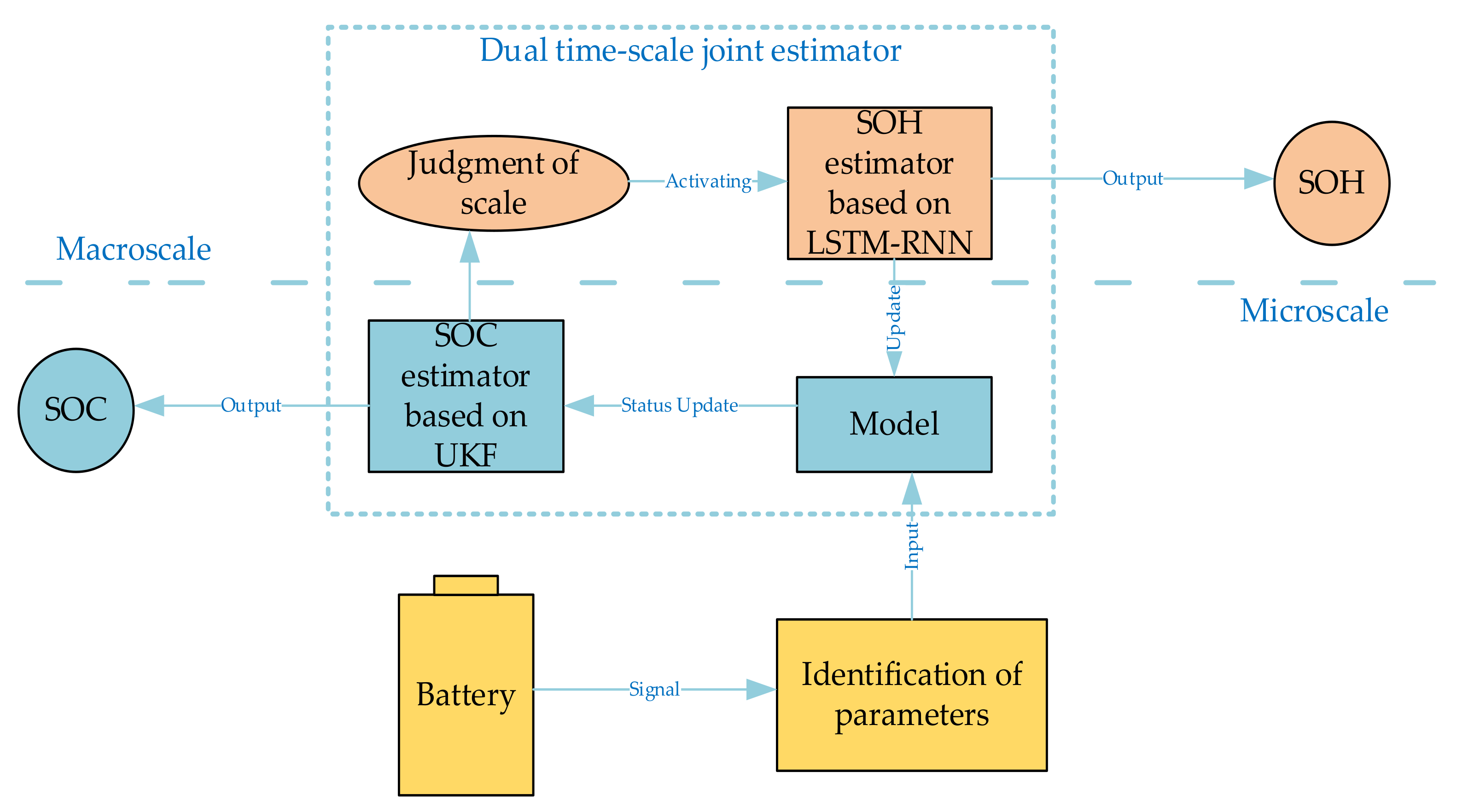
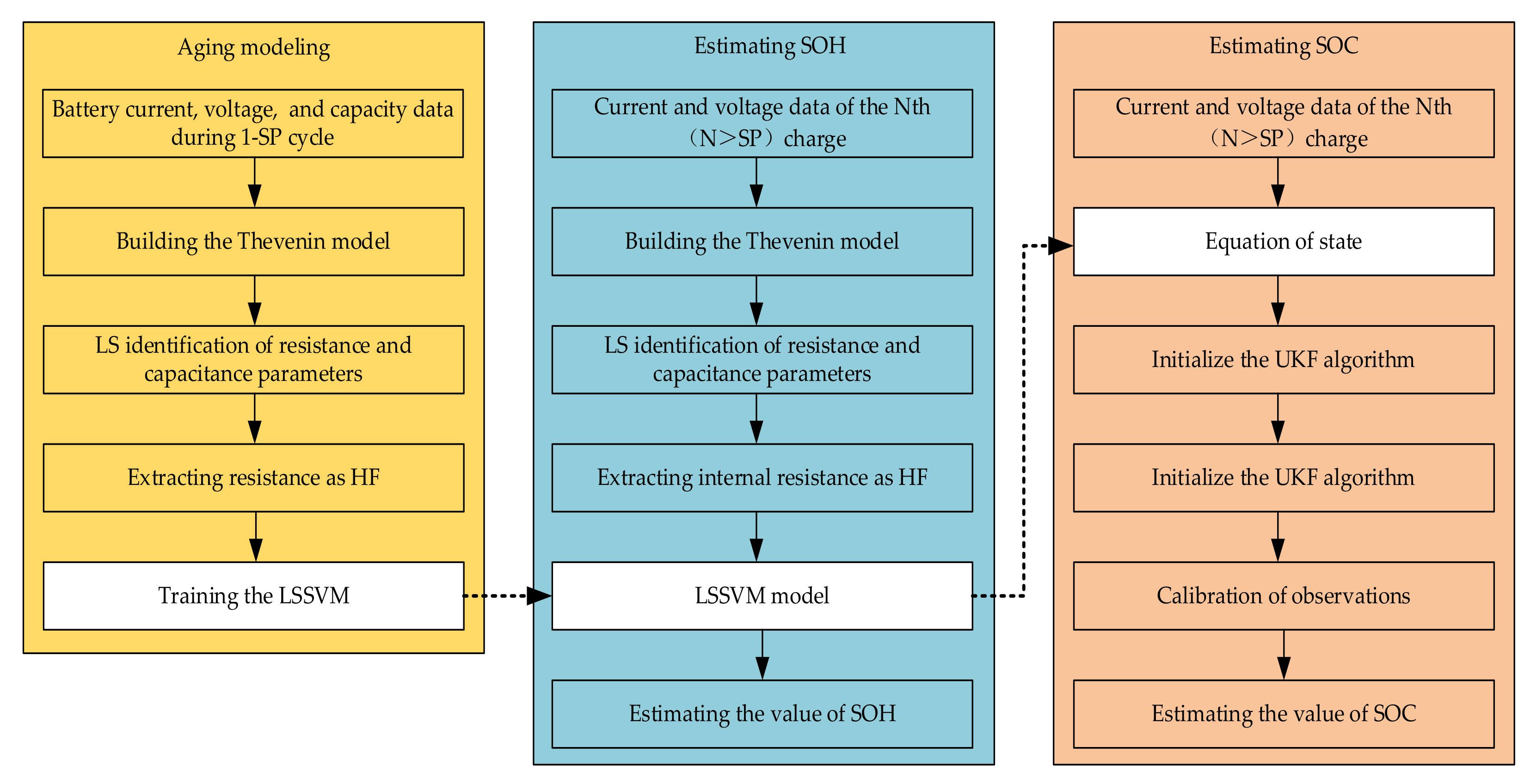

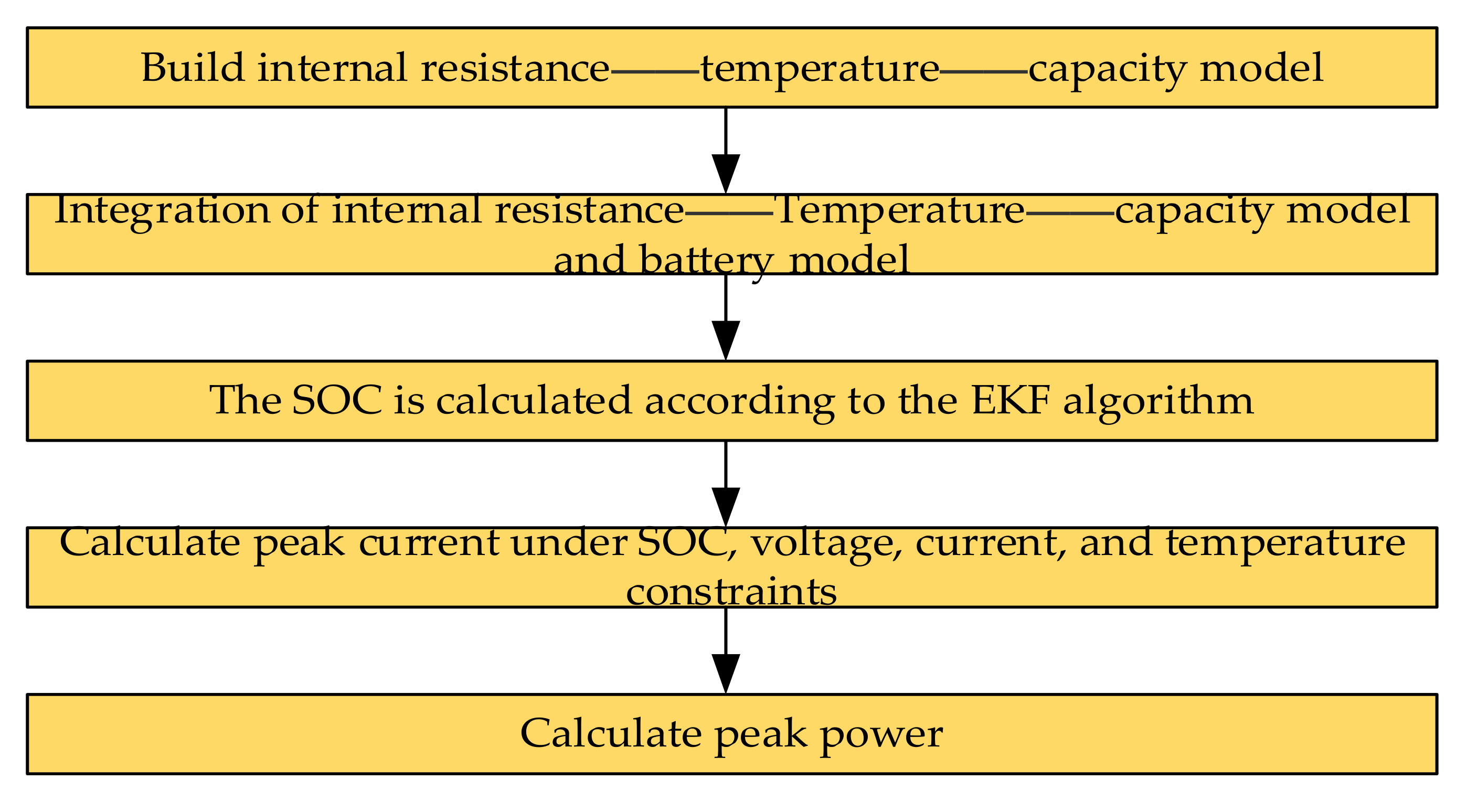
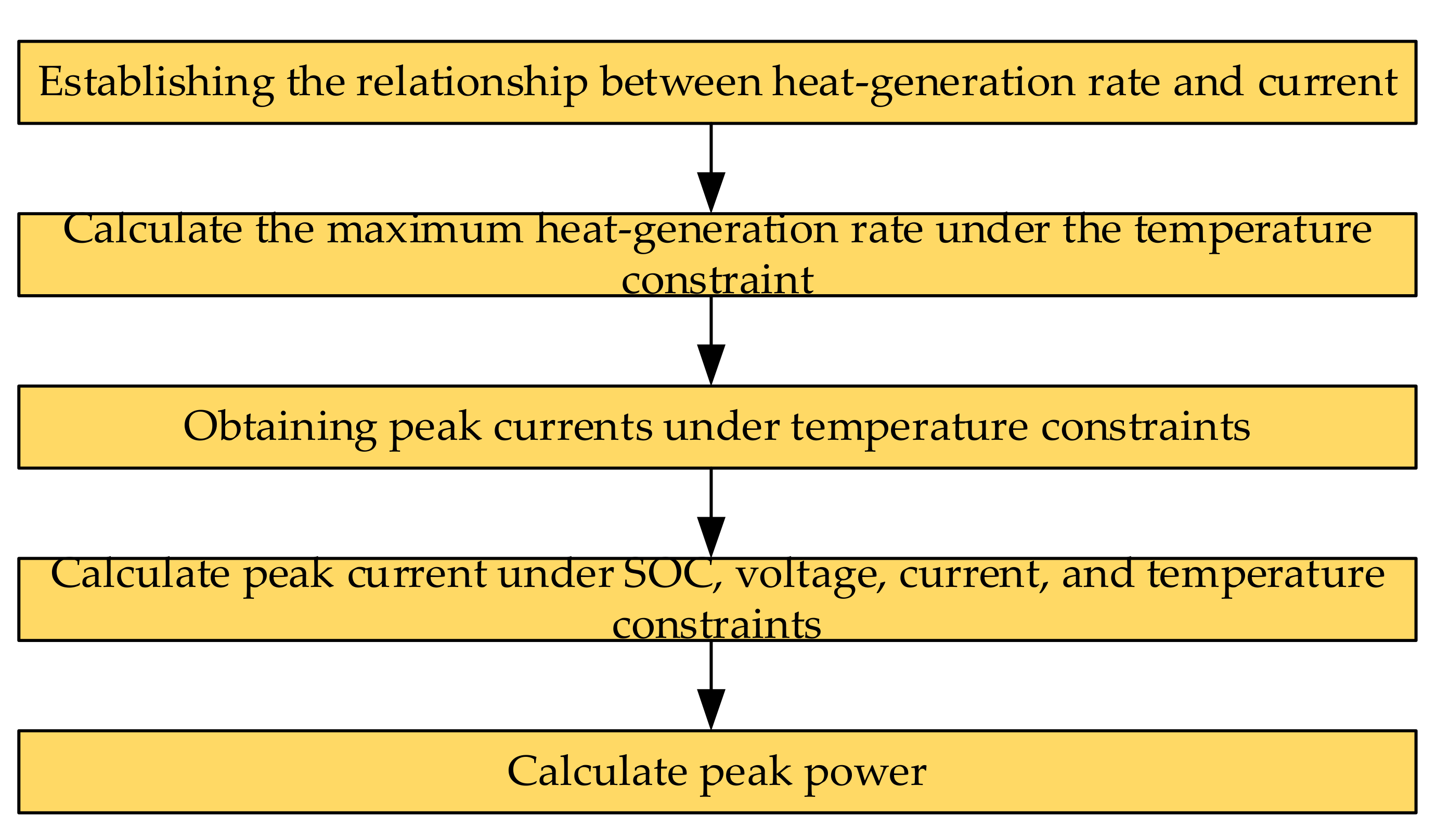
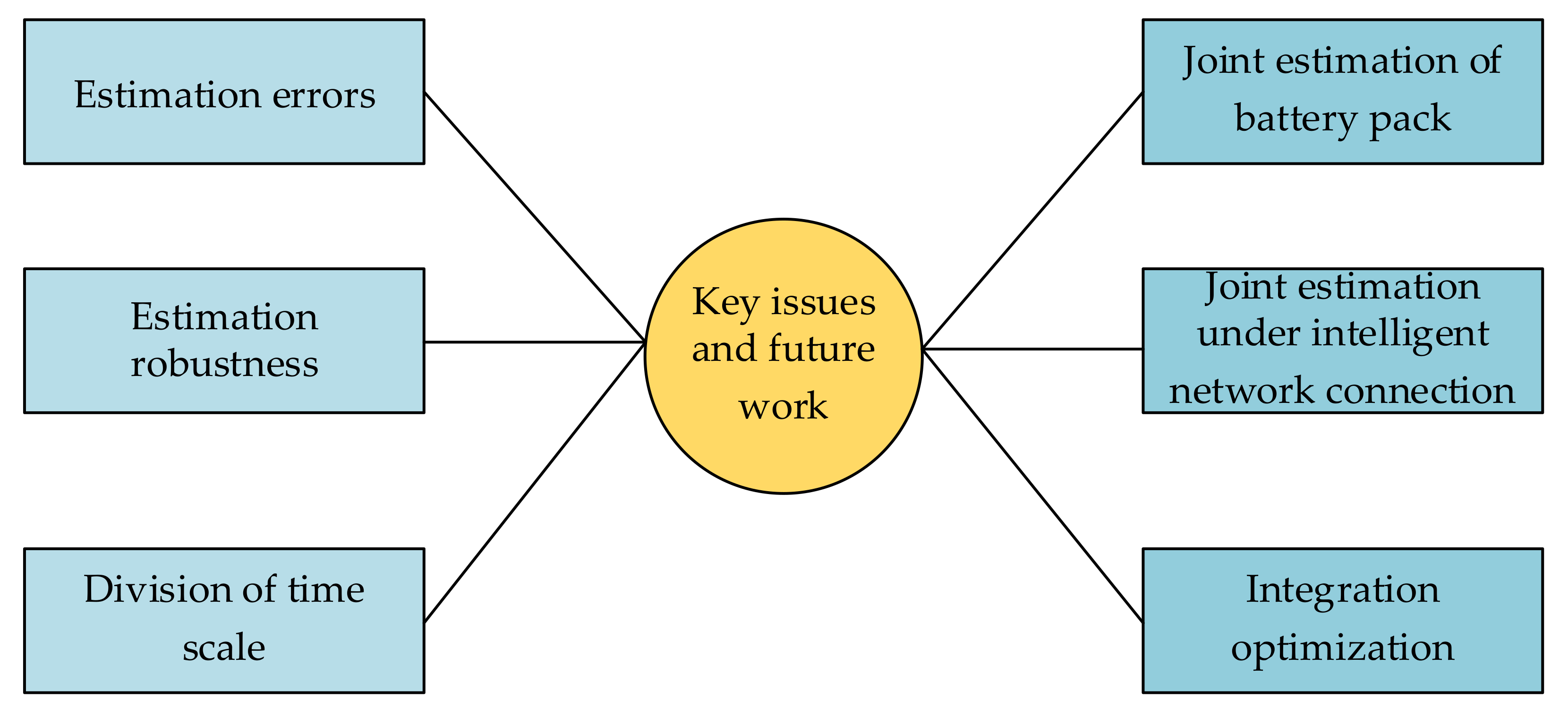
| State | References |
|---|---|
| Single-state | [6,11,15,16] |
| Dual-state | [17,19,20] |
| Estimation Methods | Types | Advantages | Disadvantages | Estimation Error |
|---|---|---|---|---|
| Experimental based [23,24,25] | Ampere-time counting. Open-circuit voltage. AC impedance | Simple principle. Reliable. | Time-consuming. Cannot be estimated in real time. Cumulative error exists | <5% |
| Model-based approaches [19,27,28] | Kalman filter. Particle filter. Sliding mode observer. | Closed-loop estimation. Low requirement for initial SOC values. | Difficult modeling. Difficult parameter identification. | <5% |
| Data-driven approach [21,27] | Neural network class. Support vector machine. Fuzzy logic. | No modeling is required. | High level of data dependency. Time-consuming. | <1.5% |
| Hybrid methods [28,29,30,31,32] | Data-model parallel mixture estimation. Data-model nested mixture model. | High estimation accuracy. Good robustness | Complex calculations. High energy consumption. Slow estimation speed. | <1% |
| Estimation Methods | Types | Advantages | Disadvantages | Estimation Error |
|---|---|---|---|---|
| Traditional estimation methods [31,32,33,34] | Capacity measurement. Resistance measurement. Differential analysis. | Simple principle. Small calculation volume. Accurate. Reliable. | Time consuming. Cannot be estimated in real time. Cumulative error exists. | <5% |
| Methods for filtering classe [32,33,34,35,36] | Kalman filter. Particle filter. Least squares. | Can be estimated in real time. High precision. Good robustness. | Difficult modeling. Difficult parameter identification. Large calculation volume. | <5% |
| Data Driven [35,36,37,38,39,40,41] | Support vector machine. Convolutional neural network. | Real-time estimation. Highly adaptive. High accuracy. | High reliance on data accuracy. Time-consuming offline training. | <1% |
| Estimation Methods | Types | Advantages | Disadvantages | Estimation Error |
|---|---|---|---|---|
| Interpolation method [14] | HPPC. | Estimation method is simple. | Requires extensive testing. No consideration of polarization and aging phenomena. | About 3% |
| Model estimation methods [42,43] | Voltage constraint. SOC constraint. Multi-constraint dynamic method. | Simple. Efficient. | Single-state estimation methods have large errors, leading to threats to the safety of the battery. | <5% |
| Data Driven [44,45] | BP neural networks. Adaptive fuzzy neural. Support vector machines. | Good self-learning ability. High accuracy. Good robustness. | Requires extensive experiments. Computationally complex and time-consuming to train offline. | <2.5% |
| Algorithms | Model | Advantages | Disadvantages | Estimation Error |
|---|---|---|---|---|
| DEKF [53,54,55] | Thevenin model | High estimation accuracy. Faster convergence. Good robustness. | The effect of ambient temperature on the battery is not considered. Individual differences in batteries are not taken into account. Calculated losses exist. | <2% |
| DUKF [9,56,57] | 2RC model | Smaller error. Higher precision. Reflects actual battery characteristics. | The effect of ambient temperature on the battery is not considered, and the individual differences of the battery are not taken into account. | <2% |
| DAUKF [56,58] | 2RC model | Fast calculation speed. High estimation accuracy. Good convergence. | Not applicable to battery packs. Calculated losses exist. | <2% |
| MIAUKF + VFFRLS [59,60,61] | 2RC model | High accuracy and robustness. | The effect of temperature on the estimation accuracy is not considered. There is a computational loss. | <2% |
| FOEKF + AUKF [58,61,62] | 2RC fractional-order model | High precision. High self-adaptability. Fast convergence speed. | Highly influenced by temperature. Not applicable with battery packs. High calculation volume. | <1% |
| Algorithms | Model | Scales | Disadvantages | Estimation Error |
|---|---|---|---|---|
| UPF + UPF [63,64] | 1RC model | SOH estimation scale is one charge/discharge cycle, SOC estimation interval is 0.1 s. | Higher precision. Lower computational volume. Low hardware requirements. | <1.5% |
| ASREKF + EKF [64,65] | Thevenin model | SOH estimation scale is one charge/discharge cycle, SOC estimation interval is 1 s. | High accuracy and low calculation volume. | <1.5% |
| FFRLS + DEKF [68,69,70] | 2RC model | SOH estimation scale is 2.5 s, SOC estimation interval is 1 s. | High stability and accuracy, saving calculation cost. | <1.5% |
| Algorithms | Data Set | Advantages | Disadvantages | Estimation Error |
|---|---|---|---|---|
| Double Recurrent Neural Netwok [17,72,73] | NASA Lithium Battery Random Use Dataset | Independence of battery model. No decoupling required. | Need to keep updating data. | <1% |
| LSTM [74] | Oxford Aging Dataset | Accuracy is higher than wavelet neural network and BP neural network, and the long-term dependency problem is solved. | No validation of effectiveness on battery packs. | <1% |
| SWPSO-DRNN [22,75,76] | Customized data sets | Higher training effect than gradient descent algorithm. High generalization ability and robustness. | Not applicable to battery packs. | <1% |
| GRN-RNN + CNN [77,78,79] | NASA Lithium Battery Random Use Dataset and Oxford Battery Aging Dataset | Avoid long-term dependence on new information, fast computation, high accuracy, and good robustness. | No validation of effectiveness on battery packs. | <1% |
| Mogrifier LSTM-CNN [79] | NASA dataset and Oxford aging dataset | Solve the problem of large local errors of LSTM method, good adaptability and high robustness. | No validation of effectiveness on battery packs. | <1% |
| Model | Estimation Method of SOC | Constraints | Advantages | Disadvantages | Estimation Error |
|---|---|---|---|---|---|
| 2RC model | EKF | Voltage, current, SOC | The estimation accuracy is higher and more robust than that without considering SOC constraints. | No consideration of temperature and aging effects. | <5% |
| 2RC model | H infinity filter | Voltage, current, SOC | Better robustness and adaptability than EKF. | No consideration of temperature and aging effects. | <2.5% |
| 2RC model | UKF | Voltage, current, SOC | High estimation accuracy and good robustness. | No consideration of temperature and aging effects | <2% |
| 2RC fractional-order model | Fractional-order adaptive extended Kalman filter (FO-AEKF) | Voltage, current, SOC | Better robustness and adaptability than EKF. | No consideration of temperature and aging effects. | <3% |
| 2RC fractional-order model | Square-root unscented Kalman filter (SRUKF) | Voltage, current, SOC | High estimation accuracy and good robustness. | No consideration of temperature and aging effects. | <2% |
Publisher’s Note: MDPI stays neutral with regard to jurisdictional claims in published maps and institutional affiliations. |
© 2022 by the authors. Licensee MDPI, Basel, Switzerland. This article is an open access article distributed under the terms and conditions of the Creative Commons Attribution (CC BY) license (https://creativecommons.org/licenses/by/4.0/).
Share and Cite
Hou, J.; Li, T.; Zhou, F.; Zhao, D.; Zhong, Y.; Yao, L.; Zeng, L. A Review of Critical State Joint Estimation Methods of Lithium-Ion Batteries in Electric Vehicles. World Electr. Veh. J. 2022, 13, 159. https://doi.org/10.3390/wevj13090159
Hou J, Li T, Zhou F, Zhao D, Zhong Y, Yao L, Zeng L. A Review of Critical State Joint Estimation Methods of Lithium-Ion Batteries in Electric Vehicles. World Electric Vehicle Journal. 2022; 13(9):159. https://doi.org/10.3390/wevj13090159
Chicago/Turabian StyleHou, Junjian, Tong Li, Fang Zhou, Dengfeng Zhao, Yudong Zhong, Lei Yao, and Li Zeng. 2022. "A Review of Critical State Joint Estimation Methods of Lithium-Ion Batteries in Electric Vehicles" World Electric Vehicle Journal 13, no. 9: 159. https://doi.org/10.3390/wevj13090159
APA StyleHou, J., Li, T., Zhou, F., Zhao, D., Zhong, Y., Yao, L., & Zeng, L. (2022). A Review of Critical State Joint Estimation Methods of Lithium-Ion Batteries in Electric Vehicles. World Electric Vehicle Journal, 13(9), 159. https://doi.org/10.3390/wevj13090159






